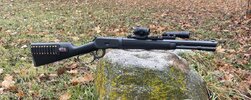Shawn Dodson
Member
- Joined
- Dec 28, 2002
- Messages
- 3,195
My primary load is 55gr M193.
For a general-purpose barrier blind expanding bullet, I handload 60gr Nosler Partition using H335.
For short-barrels, I handload Hornady 50gr GMX/CX (barrier-blind) and VMax (soft targets). The GMX bullet used to be loaded by Hornady in its "Full Boar" line of ammo.
For a general-purpose barrier blind expanding bullet, I handload 60gr Nosler Partition using H335.
For short-barrels, I handload Hornady 50gr GMX/CX (barrier-blind) and VMax (soft targets). The GMX bullet used to be loaded by Hornady in its "Full Boar" line of ammo.


